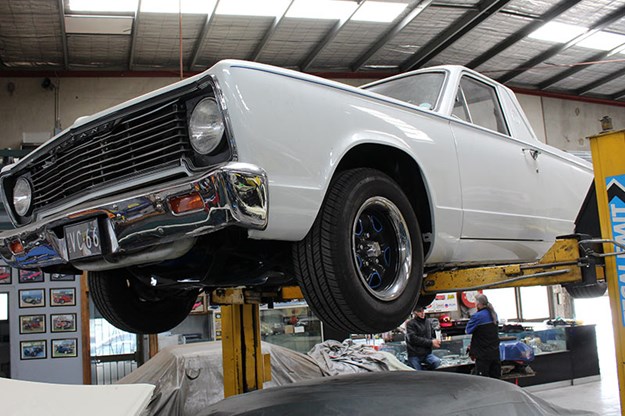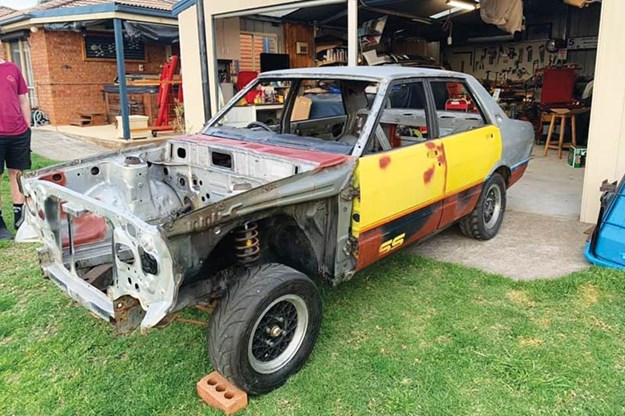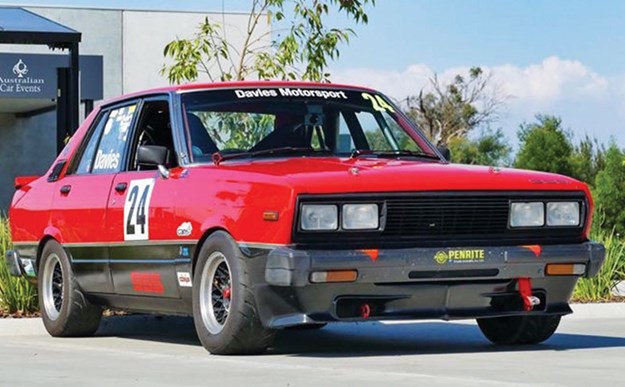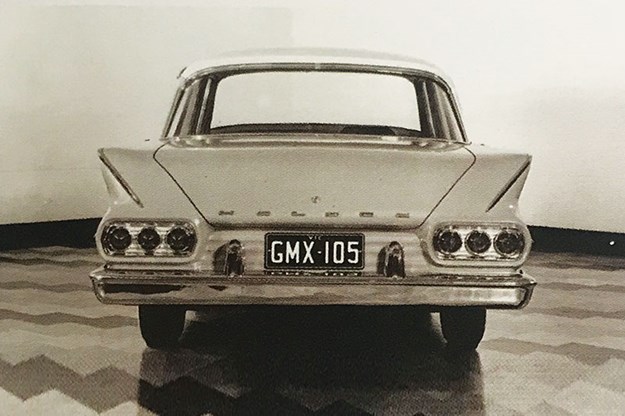Tyres, wheels and Soarers - Mick's Workshop 445



|
Datsun resto, Soarer surgery, Valiant wheels, ride heights and much more
Mick's Workshop
If you are working on that big project at home, one of the things you’ll be puzzling over is wheels and suspension. If it’s a major build where you’re making big changes, I reckon it’s an opportunity to get things right and build in some adjustability.
For example, I’ve been fitting coil-overs to a couple of builds recently and like the Viking shockers that I’ve been getting from McDonald Brothers Racing. What you do is talk them through what the car is and what sort of load we’re talking about (engine, people, type of use) and that gives them the info to choose the right spring rate.
Built into the package are three adjustments: rebound and compression damping, plus ride height on the spring. That means there is almost endless adjustment. In reality what you do is work out the combination that works for your situation – which might take a little trial and error – and then leave it alone.

A little tip here: I like to order what’s called a Torrington bearing with the package. That’s a thin set of slip rings that goes between the top of the spring and the collars. What it means is it allows a smooth adjustment as the collar comes under pressure. It’s just one of those things that makes life easier.
Now something to keep in mind is that your wheel and tyre package is part of the suspension system. And what I’m trying to say here is while giant rims with skinny tyres look tough, they’re not great in the real world. You’ll notice a lot of competition wheels, including F1, actually run pretty high aspect ratios (that is a tall sidewall in relation to the tread width) and there’s good reason for that.
So what you’re looking for in the total package is suspension that actually has room for travel – even if the overall car has been lowered – and sidewalls that have some ‘give’ in them.

A recent example for us was a lovely VC Valiant ute we’ve been working on. In that case we stuck with more or less the original suspension configuration, but made some subtle alterations to get the right stance and still have suspension. We spoke with Rod Hadfield of hotrod fame and he made us a set of drop spindles for the front. Back in the day we’d just wind off the torsion bars and put in lowering blocks. They looked great, but were terrible to ride in.
With this car, the drop axles up front meant we could wind up the preload and get the front suspension working. In the rear, we had the leaves reset. As part of the package, we did some mods that allowed us to fit later Charger wheels. They look cool and give us a decent aspect ratio that looks right for the period and works as part of the suspension package.
Here's my tip
Only Bottles

Keep one of two of your old oil bottles (the big 5lt plastic ones) aside, as they make a great emergency fluid-catcher. Screw the lid on tight, tip it on its side and cut a big window in it and you have a useful oil drain pan.
LETTERS
Hornet Monaro
LAST MONTH we got talking about the big build we’re doing for Tom’s early Monaro, and there was some discussion about the engine, which, believe it or not, had come out of a Rambler Hornet.
Marco emailed us and correctly said there was no V8 fitted to local Hornets, and questioned whether we might be rabbiting on about a 401 AMC engine.
That’s where we all got our wires crossed, and I blame Ed Guido for this (fair call – Ed). What we’ve pulled out of the Hornet was not a 401, though this was a popular transplant in the USA, if you had the money.
No, the Hornet we cannibalised had, of all things, a Chev 400 in it. So that’s what’s going into the Monaro, once it’s been pumped out to 427 cubes. Watch this space!
Just as an aside, I had hopes to do something with that Hornet, because I’ve got a big soft spot for them. But when we got it on the hoist it was too far gone – the rust had got it. So all we could do was gently lower the remains onto a flatbed and send it off to the recyclers. Better luck next time…
Old 3-Doors

Only two doors on this one!
Hi guys. First of all in issue 440 I would like to commend Darren on his restoration of the Gemini Gypsy van. It brought back memories of when I used to make them.
As we at Acacia Ridge were the only plant at the time making them, it is very likely that I would have welded the floor of that van!
Apart from the obvious appearance differences – for example side windows – what helped to make them a Euro-Japanese hybrid was the inner sill panel (on the van) came from Germany and was galvanised. The same panel on the wagons was not galvanised and came from Japan.
In issue 443, Shaun’s letter about "how many doors" and the mythical three-door Torana, brought back memories. I was there and saw that particular three-door LJ Torana when it was lifted off the line. For clarity the two doors were unfortunately on the driver side. However, I can assure you it never left the body shop!
Ken Silsby
RIGHTO, THAT solves one little mystery, I reckon. Although I can’t wait to see the response to this one. Thanks for sharing, Ken!
Heavy Breathing
If you have a 500hp Cleveland, should you run a PCV valve from the drivers side tappet cover to the back of the carby spacer, then the passenger side to a catch can with a breather? The catch can has a 10mm inlet.
Paul Williams
THE SHORT answer is yes. You could run them both into a catch can. But it’s nice to have a bit of negative pressure, which is engine vacuum with a PCV.
By having it breathing on both sides it evens up the pressure. And that’s the biggest problem you have with high horsepower engines, which is the pressure they build up inside. You need to get rid of that, or it will push oil out the dipstick and all sorts of stupid things. It’s all about equalisation.
Datsun Resto

One for the road and one for the track – Stuart Davies is building some great toys
Since you put out a call on Facebook to share some projects, here’s my latest: a full resto with period mods on a 1981 Datsun Stanza SSS. It will hopefully be painted before Christmas.
Funnily enough, I’m building it as a road-going brother to my race version.
Stuart Davies

THAT’S BRILLIANT. I love working on Japanese cars of that era, because they are dead simple and pretty tough. Plus, I like the fact a lot of them were designed from day one to accept running changes down the production line. For a restorer/modifier all these years later that means when you go to say convert an auto to a manual, the holes for the extra pedal and shifter are often already in place, while the transmission bolts straight to the back of the engine.
Let us know when you’re done, as I’m sure the Ed will want to do a story. We love seeing people’s projects, so drop me a line (and a photo!) via uniquecars@primecreative.com.au.
Soarer Surgery 1
I’ve got a similar disease to the Ed in that I have an old Soarer in the shed that I’m really enjoying. However I’m pretty sure it needs new cam belts and am wondering if it’s something I can tackle myself. I see there is a fair bit of online info – videos and ‘how to’ guides.
I can do basic work on a car, but this might be up another level for me. Thoughts?
Harley B
THERE ARE some things in life you just don’t mess with and, unless your skills are pretty good, this might be one of them. I’m going to provide some advice here that applies across a lot of engines, not just the Lexus/Toyota V8.
The reason I say to think twice about this job is, when you change the belts it opens up the opportunity to inadvertently change the cam timing. Now the consequences of this can vary from mild (runs like crap, but still runs) to wild – as in bits of engine banging into each other when they’re not supposed to.
Okay, so you have my standard warning. Now, when you decide to do it, arm yourself with a few things: an actual workshop manual would be gold as, with all due respect to the internet experts, some are good and some are full of it.
Next, check if the job requires a special tool (or tools, if there are two banks) to hold the cams in place while you remove the belts. What can happen is a cam can turn, because one of the lobes is under valve spring pressure. That will be enough to put a serious wrinkle in the plot.
The Soarer doesn’t seem to need cam-holding tools, but you will need a puller for the harmonic balancer.
Just as an aside, I’ve had specialist tools made in the past for this job on other cars. For example my Dad made me a cam holder for six-cylinder Subarus, which works perfectly.
Next, remember my old adage: check everything three times and fix it once. Remove bits slowly and carefully, photographing where they go along the way. Make sure you draw a diagram of how the serpentine belt installs, as that’s a bit if a head-spinner.
Once you’re in, check very carefully that you have the crank turned to where it should be and triple check the alignment on the belts/cams before you remove the belt, and again when you have the new one back in place.
Looking at what’s involved with a Soarer, there’s a fair bit to it, with one of the critical tasks being to ensure you get the belt tensioner lined up properly. Also, keep in mind you should replace a few other components (such as the water pump) along the way and you can buy kits.
I know Ed Guido’s car needs belts, too, and he’s happily dumping the task on me. If we get a chance, we’ll photograph the job and let you know how it goes.
Soarer Surgery 2

Doing the cam belts was a good precaution for Lyndsay’s Soarer
I’ve just had the timing belt and water pump done in my 1UZ as the engine was an unknown quantity. Is there anything else I should be looking at?
Lyndsay Rea
GOOD WORK there! I reckon you’ve done the right thing. It’s a good practice when you’ve just bought a car that doesn’t have a perfect service record to at least change the fluids and check the assorted hoses and belts.
Otherwise, that engine has a great reputation for going forever. Because it was intended as the first Lexus flagship engine, Toyota spent a bundle of money on its development. It should do 500,000km without too much stress and we have heard of one that doubled that.
M5 – Yay or Nay?
It may be asking for trouble, but I’m keen on the idea of buying an E34 BMW M5, probably one of the earlier 3.5lt cars.
What makes me nervous is the complexity and the potential for things to go wrong, particularly the electronic suspension.
Should I be worried?
Nigel Casing
THERE IS a ton of appeal in that generation M car, as they were still being hand-built at that stage. And they were straight sixes, which were great engines.
The mechanicals overall don’t worry me too much, so long as the car has been looked after. Generally they seem pretty strong. Parts can be expensive, but generally you can keep costs reasonable. These were a serious performance car for the day, so you expect to pay a bit extra to stay on top of things.
As you say, they question mark is over the electronic damper control (EDC). This is one of things that will eventually wear out, no matter how well cared-for the car is. There are people out there who can rebuild the systems, and there’s the option of replacing it entirely with a good quality set of dampers from Bilstein or similar.
I like the replacement option (remember there will be circuits that need to be blanked off as a result) as it just takes away future problems without (if its done properly) any real loss in handling quality.
There are collectors who will prefer the car be original, so that’s the risk at resale time. However if you’re removing the EDC, clean it up and keep all the components and pack them away in the shed. Then you can offer the original kit in a sale.
TRIVIAL PURSUIT
The Chev look

Back in 1958 some of the design proposals for the EJ Holden included quad headlights and a pronounced set of six tail-lamps, giving the whole thing a very strong Chevrolet flavor. However the design was stripped back considerably by the time it reached production.
(See the Shannons series Design to Driveway.)
Want some advice on a build or a potential car purchase. Heck we’ll even tackle long distance diagnosis.
Drop us a line at uniquecars@primecreative.com.au
From Unique Cars #445, Oct 2020
Unique Cars magazine Value Guides
Sell your car for free right here
Get your monthly fix of news, reviews and stories on the greatest cars and minds in the automotive world.
Subscribe

.jpg)










.jpg)

